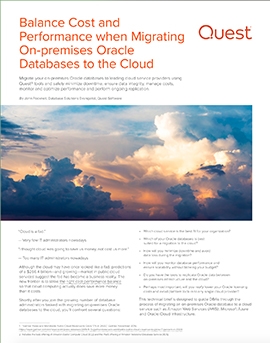How is your database performance holding up in the midst of all the #WorkingFromHome (WFH)? Are you relying on database monitoring more than before COVID-19? Less? About the same?
It’s not so hard to combine database monitoring with keeping social distance, of course. You’ve probably been monitoring your company’s databases remotely for ages, to check on uptime, workload and resource utilization from home or from another country.
But more is riding on it in the era of WFH. Your co-workers are more dependent on high-performing databases because they too are out of the office. In fact, maybe nobody is in your office now, and you’ll face big delays in resolving problems if a production database should run out of resources.
Lousy database performance in the era of WFH
When database performance falls off, the fingers start pointing at the usual suspects:
- the databases
- CPU
- memory
- disk space
- network throughput
- the applications themselves
But WFH adds a few more suspects:
- VPN
- firewall
- internet service provider
Your co-workers are triple-clicking on “Refresh,” grousing about their ISP and poking around in their VPN settings, trying to figure out what’s hampering performance. Not a happy scenario for them, much less for you, the database administrator (DBA).
Here are three ways that database performance, database monitoring and just plain keeping things stable have become even more important in these last few weeks.
1. Database cloud migration
“We were so close to completing our Oracle and PostgreSQL database migration to the cloud,” you tell your fellow DBAs on a conference call. “Then the pandemic hit and now everybody’s working from home, including us. I’d really like to finish all the migrations, but this is not the most certain of times. I don’t want to do anything that will affect database performance.”
“We weren’t even close to finished,” says your colleague across the pond. “We were just about to start migrating SQL Server and MySQL databases. We still had a long way to go, and now it looks as though we’ll have to put everything on hold.”
It seems like a good time to play things safe. But you had good business and technical reasons when you decided to move to the cloud, and those still matter. So what’s the best way to proceed with your cloud migration plans?
The risk doesn’t have that much to do with migrating to cloud databases in a pandemic. The risk lies in migrating to a poor fit and ending up with lousy database performance after all that work. Not to mention leaving your WFH co-workers with no way to access their data.
There’s a correlation between database performance in the cloud and how much it costs you each month. That means your main goal is to balance the cost against the performance of your cloud service. Knowing your database performance before and after migration is the best way to measure whether the migration was successful.
2. SQL performance tuning
We posted last time about benchmarking databases and optimizing SQL to boost performance. Database performance monitoring plays a role there as well.
Suppose users complain that your applications are sluggish. You check whether your databases are running fine by running a couple of scripts and notice that CPU and disk I/O are peaking but you have no idea why
You dig a bit deeper and begin to realize that the slowdown may be due to the application executing inefficient SQL statements. But that’s a tough sell to the developers, who are not easily convinced that their code is running offensive database queries.
Monitoring and investigating what’s really happening inside the databases is the best way to identify where the bottlenecks occur so that the developers can optimize their SQL statements.
3. A seat at the table
In normal times, companies check their pulse every week or so. In these abnormal times of quarantines and lockdowns, when employees have been told to stay at home, is your company checking its pulse more frequently? Like daily, perhaps?
As part of IT operations, some DBAs may get a seat at the executive staff table. You’ll want your seat to be the result of keeping your infrastructure steady and your cross-platform database resources allocated wisely. But if they aren’t — say, because users are complaining that they can’t be productive at home — then you’ll want diagnostics and analytics that indicate what and where the problem is, and how to resolve them.
Next step
A deep dive into database performance will help whether you’re migrating to the cloud, optimizing your application performance by hunting for inefficient SQL statements, or briefing your execs on how WFH is going.
If you’re migrating Oracle databases to the cloud, have a look at our technical brief, Balance Cost and Performance when Migrating On-premises Oracle Databases to the Cloud. It offers a clear picture of Oracle-to-cloud migration and insights into balancing cost and performance.
Also, we’ve put together a technical brief called Tools for the Evolving Database Administrator. It’s an overview of Foglight for Cross-Platform Databases, our product for addressing all three scenarios described above. Have a look at it for ideas on how and where to find database performance bottlenecks.
Balance Cost and Performance when Migrating On-premises Oracle Databases to the CloudYes, there’s a pandemic going on, and yes, you’re #WorkingFromHome. But that doesn’t mean you have to put your database migration plans on hold indefinitely. By monitoring database performance, you can keep an eye out for potential bottlenecks that threaten a smooth application experience for your work-from-home colleagues. And you can proceed with your migration. This technical brief is designed to guide DBAs through the process of migrating an on-premises Oracle database to a cloud service such as AWS, Azure and Oracle Cloud Infrastructure. Get a clearer picture of how to balance cost and performance. |
Related information
Blog: Database development and management while working from home [IT and Covid-19]
Information Management Remote Solutions: Database Management While Working from Home
Got questions?
If you’ve got questions, we’ve got answers. Contact us!
Help your colleagues
If you think your colleagues would benefit from this blog, share it now on social media with the buttons located at the top of this blog post. Thanks!



